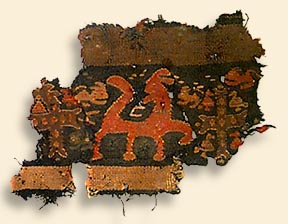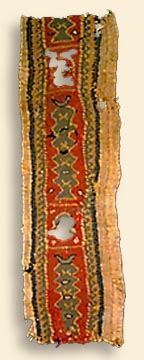

The History of the Copts
Fragment of an Ecclesiastical
Tapestry from Bawit (?)
CAS 0389-2380

The cultures which most influenced the Coptic period of Egypt include the ancient Egyptians, the classical Greeks, and the Romans. The influence of these cultures is visible in Coptic art. For example, many Coptic textiles incorporate some ancient Egyptian symbols and motifs, including the ankh, the cross-like symbol for life. The ankh was used as an alternate form of the Christian cross, and some textiles incorporate both symbols. However, Coptic art in general shows the stronger influence of the Greeks and Romans.
Description: The decorated
band features a strange quadruped in the center. To the right of it is a jeweled
cross with four birds in the angles between. To the left of the quadruped is
an empty jeweled throne. Small animals act as fillers in the background spaces.
The colors of the design include dull yellow, brick red, dull green and indigo
blue. The motifs of jeweled crosses with birds in the angles and jeweled empty
thrones are found in other collections. These motifs are Christian, the cross
symbolizes the Transfiguration of Christ and the throne symbolizes the second
coming of Christ. Materials/Construction: The fragment is made entirely of wool
and woven in tapestry weave. Measurement: 12.4 x 17.5 cm. Date: Sixth century.
Accession number: CAS 0389-2380.
After the Pharaohs ruled in Egypt in the several thousand years before the common era, there were various rulers of Egypt, including the Assyrians and Persians, but they did not leave much of an influence on Egyptian culture. Alexander the Great conquered Egypt in 332 BCE and founded the city of Alexandria, a planned model Greek city.
The Macedonian Ptolemies
took control after Alexander the Great. During the 300 years of their rule,
many Greeks settled in Alexandria, which flourished as an intellectual center
of Hellenistic culture, philosophy, art, and trade. Egyptian society was stratified,
with the Greeks being the ruling class, but the Egyptians had many important
roles. Much of Coptic art features classical Greek subjects, due to the
strong artistic influence left from the 300 years of Greek rule and encouraged
by the preferences of the Roman rulers.
Egypt had a stable economy under the Ptolemies, but when Egypt was conquered by the Romans in 30 BCE, the Egyptians' autonomy was restricted. The Romans designated Egypt a province, and made harsh demands for agricultural produce and taxes. There was no real movement out of social classes. The distress the Egyptians faced created a spiritual void and led to a revival in the ancient belief in life after death.
Coptic tradition claims that St. Mark brought Christianity to Egypt around 50 CE. A small community of Christians developed in Alexandria in the late first century, and became more numerous by the end of the second century. Some similarities in beliefs helped Christianity to be accepted by Egyptians, including the beliefs that the Egyptian god Osiris was both human and god, the resurrection of Osiris, and the godly triad of Osiris, Isis, and Horus.

During
the third and fourth centuries, the Romans persecuted various religious dissidents,
especially Christians. The emperor Diocletian attempted to restructure and unify
the Empire, and instigated some harsh reforms which led to rebellion among the
Egyptians. Diocletian then began extensive persecutions of Christians, which
was referred to by Copts as the Era of Martyrs. The year of Diocletian's accession
(284 CE) was designated Year One in the Coptic Christian calendar in order to
observe the tragedies. Christianity was threatening to the Roman Empire because
its strong monotheistic belief "made it impossible for its serious adherents
to acknowledge the Roman emperor as a deity" (Carroll 1988). Also, many important
leadership positions in Egyptian society and the military were held by Christians.
The emperor Constantine ended the persecutions of Christians in 313 CE with the Edict of Milan, which proclaimed general religious toleration. Later, Constantine established Christianity as the state religion of the eastern empire, and was intolerant to certain pagan practices, including mummification. Prior to this, mummification had lessened in custom in Egypt for various social and economic reasons. The end of the fourth century is regarded as the beginning of the Byzantine period.
By the middle of the fourth century, the Christian church was well organized in Egypt, and much of the scripture and other literature was written in Coptic. The Coptic language was the vernacular Egyptian, written in the Greek alphabet with a few additional letters. Some important contributions the Copts made to Christianity were the practice of Christian monasticism and the theory and practice of asceticism.
The Coptic Church split
from the rest of Christendom over a political disagreement of doctrine at the
Fourth Ecumenical Council at Chalcedon in 451 CE. The argument concerned whether
Jesus had one or two natures (monophysitism vs. diophysitism). The Byzantine
patriarchs in Egypt persecuted the Copts who did not convert to their version
of Christianity. The Copts became more isolated and nationalistic, wrote more
in the Coptic language, and their art became more unified.

The Copts were so oppressed under the Byzantine administration that they did not assist the Patriarch Cyrus when Egypt was invaded by the Arabs in 641 CE. The Copts were treated well at first under the Arabs and continued to have important roles in society, including the arts and crafts. Later the Arabs began to tax Christians more heavily and deny them privileges, so many Copts chose to convert to Islam. Arabic increasingly became the official language in Egypt.
Then during the eleventh and twelfth century Crusades, the Copts were harassed by the Arabs for being Christian, and by the Crusaders for being heretics. The Copts continued to convert to Islam or emigrated to other countries, and their population in Egypt dwindled to a minority. The Copts' decrease in number and voice contributed to the oversight of their importance in history. Today, the Copts compose about six percent of the population in Egypt.
Description: The design on the textile is a continuous band with spiral wave borders. The center consists of squares and rectangles with an abstract floral design inside. The colors are yellow, red, medium green and dark gray. Materials/Construction: The textile is made of wool and line weft on linen warp. It is made by tapestry weave with edge selvages, one strongly reinforced with extra warp threads. Measurement: 20 x 6 cm. Date: Tenth century. Accession number: CAS 0389-2579.
| Coptic Textiles Home | History of the Copts | Coptic Stylistic Groups | Coptic Weaving Technology |
| Coptic Textiles Collection | Resources | Online Exhibits Home | Anthropology Home |